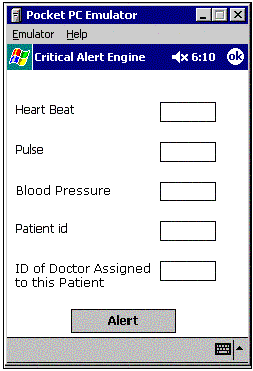What is Critical Alert Engine (CAE) ?
In a typical multi-storey hospital complex, the Intensive Care Unit (ICU)
is located in a specific portion of the building. But the doctors keep moving
about the entire hospital complex, attending to various patients,
and locating them or contacting them quickly at a time of emergency
becomes an issue of concern.
Critical Alert Engine (CAE) empowers the nurses and other medical
professionals involved in treating critical patients in the ICU, by
enabling real time communication between the ICU and the doctor. A
Pocket PC with wireless connectivity is provided to the doctors,
nurses and other medical professionals involved in treating the ICU
patients. The nurses can send critical alerts and notification messages
to doctors about the status of a patient and ask for immediate action
to be taken. Hence it becomes easier to track a doctor assigned to a
specific patient in real time. This results in improved collaboration
and coordination within the team, thus providing mission critical
care to patients.
Example: If a patientís heart rate crosses a certain value, it could
mean that the patient needs immediate attention. In such a scenario,
the nurse could send a message to the doctor (through her Pocket PC),
with critical details like current heart rate, blood pressure, pulse rate etc.
As the communication happens instantly in real time, the doctor would respond
immediately (either through a reply message giving directions for first-aid
to the nurse or by physically coming to the ICU)
CAE System Design

The CAE possesses a two-tier architecture viz. the PocketPC Front
End and the Hospital Back-End. These components are explained
below:
-
PocketPC Front End:
This component of CAE is built as consisting of the following three
sub-components:
-
CAE Alert Capture Interface: The CAE Alert Capture Interface
provides the necessary UI to gather the required critical data
about the ICU patient who needs immediate attention.
The doctorís id to whom an alert needs to be sent is also
entered and the alert is dispatched. The form is designed
to be simple and quick-to-fill. A screen shot of the
CAE Alert Capture Interface obtained on a PocketPC Emulator
is shown below:

-
Critical Data SQL Server CE Database: The Critical Data SQL Server
CE Database is an efficient local store on the PocketPC, of the
critical patient data obtained in the ICU from the the
CAE Alert Capture Interface. It comprises a single table called CriticalData
with a schema suited to store critical patient data. SQL Server CE
makes application development easy while providing a consistent development
model and API. It is also a robust, feature-rich mobile database solution with
a relatively small footprint. It includes a query processor, merge-replication
and synchronization capabilities.
-
AlertDoc XML Web Service Client: In order that a doctor
who receives the alert from the ICU take suitable actions,
it is necessary that the data obtained at the ICU be
communicated to the doctor. CAE provides
a mechanism for this purpose through a simple XML Web Service
made available on the hospital server (as we shall discuss soon).
The AlertDoc XML Web Service Client
is a client of this XML Web Service and runs on the PocketPC.
When invoked, the client connects to the hospital server via
Wi-Fi connectivity, makes a call to the XML Web Service,
funnels the
ICU patient data to the XML Web Service (which in turn fires
an alert
to the doctor packaging the data with the alert).
-
Hospital Back-End:
This component of CAE is built as consisting of the following two
sub-components:
-
AlertDoc XML Web Service: As mentioned earlier, CAE
provides a XML Web Service based solution for communicating
the critical ICU patient data gathered on
the nurse's PocketPC to the doctor.
AlertDoc XML Web
Service is the XML Web Service which runs on the hospital server
and enables
the PocketPC to push the ICU patient data.
It should be noted that the AlertDoc XML Web Service receives
from the PocketPC, the ID of the doctor to be alerted.
Individual doctor profiles are stored on the hospital
servers with details on mode through which the doctor
can be reached at specific times. Currently supported
communication modes are Email and SMS. The AlertDoc XML
Web Service
reads the profile of the doctor to be alerted and
gets the mode through which the doctor has to be contacted
currently. The AlertDoc XML Web Service then sends an
Email to the doctor or an SMS to his/her cellphone
as the case may be.
To provide for redundancy in communication, AlertDoc uses
a pre-configured database of back-up doctors in case
the alert cannot be successfully delivered.
-
Hospital SQL Server Database: The Hospital SQL Server
Database is
persistent store at the hospital site which houses the profiles
of individual doctors. The AlertDoc XML Web Service uses this
database to determine the mode by which an alert has to be
delivered to the doctor. In addition, each ICU alert is
logged in the database for future reference.
Summary
Thus the CAE enables real time alerts between the
ICU and the doctors. The critical patient details
are packaged along with the alert so that the doctor may
be made aware of the actual patient state even before
he reaches the ICU. There is enhanced collaboration among
the members of the hospital team; timely, mission critical
care is made available to the patients.
|


